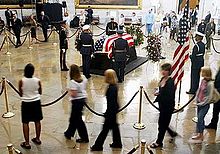United States[edit]
See also: State funerals in the United States
For most federal officeholders, lying in state is the rare honor granted by the United States to a deceased official wherein his or her remains are placed in the rotunda of theUnited States Capitol in Washington, D.C., for public viewing. The casket is guarded by members of the armed forces. By regulation and custom, only Presidents, military commanders, and members of Congress are granted the honor of lying in state. Except for Presidents and former Presidents, the honor is not automatic. Not all those entitled to the honor accept it, however. The first leader to receive this honor was former Speaker of the House of Representatives Henry Clay when he died in 1852. Since then, the honor has been extended to thirty-one people, including eleven Presidents.
The process of lying in state at the Capitol is as follows. The coffin or casket is usually placed on a catafalque, usually the Lincoln catafalque, so named as it was constructed upon the death of Abraham Lincoln, from when he lay in state following his assassination in 1865. The casket is guarded at each of its corners by servicemen from each of the branches of the armed forces for its duration at the Capitol. In contrast to the practice in the United Kingdom and other countries of the Commonwealth, guards at the Capitol face the casket, hold their rifles with their right hand, and keep the rifle butt resting on the floor. After the viewing and ceremony at the Capitol, the remains are taken to the burial location.
- 1852 – Henry Clay, long-serving Senator and Representative, Secretary of State, Speaker of the House, and presidential candidate
- 1865 – President Abraham Lincoln, assassinated while in office
- 1868 – Thaddeus Stevens, Representative from Pennsylvania
- 1874 – Charles Sumner, Senator from Massachusetts
- 1875 – Vice President Henry Wilson, served under Grant, died in office
- 1881 – President James Garfield, assassinated while in office
- 1886 – John A. Logan, Senator from Illinois
- 1901 – President William McKinley, assassinated while in office
- 1909 – Pierre L'Enfant – although he died in 1825, he was disinterred, lay in state before reinterment at Arlington National Cemetery
- 1917 – Admiral George Dewey, Admiral of the Navy
- 1921 – The Unknown Soldier for World War I
- 1923 – President Warren Harding, died in office
- 1930 – President William Howard Taft, President 1909–13, also Chief Justice 1921–30
- 1948 – John J. Pershing, General of the Armies of the United States
- 1953 – Robert A. Taft, U.S. Senator and Majority Leader
- 1958 – The Unknown Soldiers for World War II and the Korean War
- 1963 – President John F. Kennedy, assassinated while in office
- 1964 – General Douglas MacArthur, General of the Army
- 1964 – President Herbert Hoover, President 1929–33
- 1969 – President Dwight Eisenhower, President 1953–1961, Supreme Allied Commander during World War II
- 1969 – Everett Dirksen, Illinois Senator, Senate Minority Leader 1959–1969
- 1972 – J. Edgar Hoover, FBI Director 1929–1972
- 1973 – President Lyndon B. Johnson, President 1963–1969
- 1978 – Hubert Humphrey, Vice President 1965–1969, Minnesota Senator
- 1984 – The Unknown Soldier for the Vietnam War (later identified as 1st. Lt. Michael J. Blassie)
- 1989 – Claude Pepper, long-serving Senator and Representative
- 2004 – President Ronald Reagan, President 1981–1989
- 2006–07 – President Gerald Ford, President 1974–1977
- 2012 – Daniel Inouye, President pro tempore of the U.S. Senate, Senator from Hawaii, and recipient of the Medal of Honor
The United States Congress has created a similar—though not identical—privilege for distinguished Americans who do not qualify for a lying in state designation. The process of lying in honor is very similar to that of lying in state with the exception that the honor guard in the Rotunda is provided by the Capitol Police or another suitable source.
Those who have lain in honor are as follows:
- 1998 – United States Capitol Police Officer Jacob Chestnut and Detective John Gibson
- 2005 – Civil Rights Activist Rosa Parks[7][8]
In 1998, Russell Eugene Weston Jr. stormed the Capitol and shot and killed Chestnut and Gibson. In response, Congress provided for their remains to lie in honor in the Rotunda. Chestnut was the first African-American to lie in honor. In 2005, upon the death of civil rights activist Rosa Parks, Congress permitted her remains to lie in honor at the Rotunda as well; Parks became the second African-American and the first woman to lie in honor in the Capitol Rotunda.
Supreme Court Justices lie in state in the Great Hall of the United States Supreme Court Building. Justices who have been awarded this honor include:
- 1974 – Chief Justice Earl Warren
- 1993 – Justice Thurgood Marshall
- 1995 – Chief Justice Warren E. Burger
- 1997 – Justice William J. Brennan, Jr.
- 1999 – Justice Harry A. Blackmun
- 2005 – Chief Justice William H. Rehnquist, the first so-honored to have died in office.






No comments:
Post a Comment